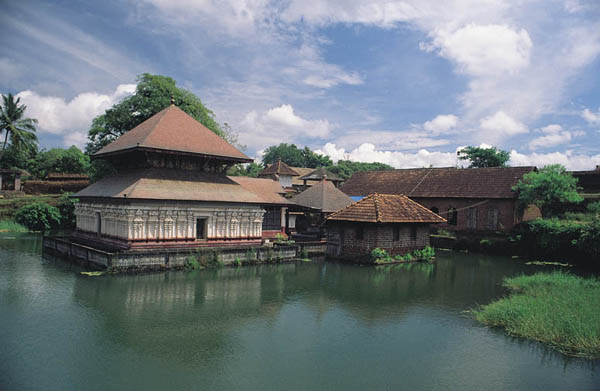The god Parashurama, "Rama with the battle-axe", the sixth incarnation of Vishnu, is credited with
creating Kerala. Born a brahmin, he set out to re-establish the supremacy of the priestly class, whose position had been usurped
by arrogant
kshatryas , the martial aristocracy. Brahmins were forbidden to engage in warfare, but he embarked upon
a campaign of carnage, which only ended when Varuna, the all-seeing god of the sea, gave him the chance to create a new land
from the ocean, for brahmins to live in peace. Its limits were defined by the distance Parashurama could throw his axe; the
waves duly receded up to the point where it fell. Fossil evidence suggests that the sea once extended to the Western Ghats,
so the legend reflects a geological truth.
Ancient Kerala is mentioned as the land of the Cheras in a third-century BC Ashokan edict, and also in the
Ramayana (the monkey king Sugriva sent emissaries here in search of Sita), and the Mahabharata (a Chera king
sent soldiers to the Kurukshetra war). The Tamil Silappadikaram ("The Jewelled Anklet") was composed here and provides
a valuable picture of life around the time of Christ. Early foreign accounts, such as in Pliny and Ptolemy, testify to thriving
trade between the ancient port of Muziris (now known as Kodungallur) and the Roman Empire.
Little is known about the early history of the Cheras; their dominion covered a large area, but their capital Vanji has
not been identified. Other contemporary rulers included the Nannanas in the north and the Ay chieftains in the south, who
battled with the Pandyas from Tamil Nadu in the eighth century. At the start of the ninth century, the Chera king Kulashekhara
Alvar - a poet-saint of the Vaishnavite bhakti movement known as the alvars - established his own dynasty. His
son and successor, Rajashekharavarman, is thought to have been a saint of the parallel Shaivite movement, the nayannars
. The great Keralan philosopher Shankaracharya, whose advaitya ("non-dualist") philosophy influenced the whole of Hindu
India, lived at this time.
Eventually, the prosperity acquired by the Cheras through trade with China and the Arab world proved too much of an attraction
for the neighbouring Chola empire, who embarked upon a hundred years of sporadic warfare with the Cheras at the end
of the tenth century. Around 1100, the Cheras lost their capital at Mahodayapuram in the north, and shifted south to establish
a new capital at Kollam (Quilon).
When the Portuguese ambassador/general Vasco da Gama and his fleet first arrived in India in 1498, people
were as much astounded by their recklessness in sailing close to Calicut during monsoon, as by their physical and sartorial
strangeness. Crowds filled the streets of Calicut to see them, and a Moroccan found a way to communicate. Eager to meet the
king, whom they believed to be a Christian, the Portuguese were escorted over 29km in torrential rain to his palace. However,
da Gama soon found that the gifts he had brought from the king of Portugal had not made a good impression. The zamorin (raja)
wanted silver and gold, not a few silk clothes and a sack of sugar.
Vasco da Gama, after such diplomatic initiatives as the kidnapping, mutilation and murder of assorted locals, nevertheless
came to an agreement of sorts with the zamorin, and then pressed on to demand exclusive rights to the spice trade. He was
determined to squeeze out the Keralan Muslim ( Mappila ) traders who for centuries had been a respected section of
the community, acting as middlemen between local producers and traders in the Middle East. Exploiting an already existing
enmity between the royal families of Cochin and Calicut, da Gama turned to Cochin, which became the site of India's first
Portuguese fortress in 1503. The city's strategic position enabled the Portuguese to break the Middle Eastern monopoly of
trade with western India. Unlike previous visitors, they introduced new agricultural products such as cashew and tobacco,
and for the first time turned coconut into a cash crop, having recognized the value of its by-products, coir rope and matting.
The rivalry between Cochin and Calicut allowed other colonial powers to move in; both the Dutch, who forcibly expelled
the Portuguese from their forts, and the British, in the shape of the East India Company, established themselves early in
the seventeenth century. During the 1700s, first Raja Martanda Varma and then Tipu Sultan of Mysore carved out independent
territories, but the defeat of Tipu Sultan by the British in 1792 left the British in control right up until Independence.
Kerala today can claim some of the most startling radical credentials in India. In 1957 it was the first state in
the world democratically to elect a communist government and despite having one of the lowest per capita incomes in the country
it has the most equitable land distribution, due to uncompromising reforms made during the 1960s and 1970s. In 1996, the Left
Democratic Front, led by CPI(M) retook the state from the Congress-led United Democratic Front, who had been in power for
five years. Poverty is not absent, but it appears far less acute than in other parts of India. Kerala is also justly proud
of its reputation for health care and education, with a literacy rate that stands, officially at least, at 100 percent. However,
industrial development is negligible, with potential investors from outside tending to fight shy of dealing with a politicized
workforce. Too many graduates and too little investment has led a significant proportion of the male workforce to seek lucrative
employment overseas in the Gulf states; it's now hard to find a family who does not have at least one relative sending substantial
wealth back to Kerala. As you explore the state, you cannot fail to notice the most obvious status symbol of remittance culture
- the vast pink-and-white mansions sprawling incongruously on the outskirts of every village.
